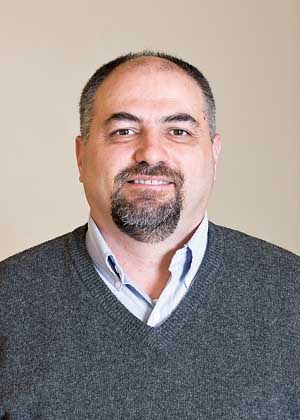The arsenal of information growers can bring to bear on the question of which rootstock to use has grown again.
Recently published research by a team of U.S. Department of Agriculture and Cornell University scientists says growers should match rootstocks’ varying abilities to absorb minerals to the minerals available where they are to be planted.
The research points to a day when growers may be able to adjust fertilization programs according to what rootstock forages well on its own versus one that doesn’t.
“Rootstocks differ in their ability to forage for minerals, and this affects fruit quality,” said Dr. Gennaro Fazio, the lead researcher and a plant breeder and research geneticist with the USDA Agricultural Research Service’s Plant Genetic Resources Unit in Geneva, New York.

Gennaro Fazio
The impact of this work could well be felt all along the fruit production and marketing chain. “Some packers measure the concentration of several nutrients in lots of apples to estimate storage ability and storage disorders already,” Fazio said.
Others are giving the idea a long look. “It’s something we are considering for use in the future,” Lee Showalter, grower services and food safety manager at Rice Fruit Co. of Gardner, Pennsylvania, told Good Fruit Grower.
Growers might find ways to reduce input costs: If one rootstock is more efficient at potassium or phosphorus uptake, Fazio said, they may not have to apply as much of either.
The knowledge can also be used to reduce the occurrence of fruit defects.
“We know that too little calcium, too much potassium and too much magnesium can bring on bitter pit,” he said. “Knowing how well rootstock absorbs and transports these minerals can drive the decision of which scions to graft.”
Some rootstocks pass along fairly equal nutrients to scions, while others may be very good at passing along particular minerals, such as calcium.
Fazio’s earlier research showed some Geneva rootstocks are up to 25 percent better at sending potassium up the chain. They also detected three chromosomes having an effect on calcium delivery and another for sodium.
But what happens after the graft needs more research. “We don’t have the knowledge of how proficient scions are at moving certain nutrients,” he said.
For now, however, Fazio and his team have tracked down a number of positive correlations between various minerals in certain apple rootstocks in New York soils.
Differing soil types notwithstanding, the study’s findings can be used in other fruit growing regions of the country, such as the Pacific Northwest, Fazio said, because rootstocks’ genetic material remains unchanged no matter where it is planted.
The same is true for rootstocks’ nutrient absorption and transport mechanisms.
Trial and results
Fazio and his team took plant material — leaves and fruit — from mature apple rootstock with Honeycrip, Fuji and Enterprise scions in New York’s Champlain Valley, Hudson Valley and Lake Ontario apple growing regions, as well as Cornell University’s Lake Geneva Experiment Station.
They oven-dried leaf and tissue samples, then ground them up and analyzed them for nutrient levels and carbon and nitrogen concentrations. In addition, they collected soil samples from the Champlain and Hudson Valley sites and analyzed them for soil nutrients.
Soil analysis of the Hudson Valley sample showed optimal levels of phosphorus and potassium and very high levels of calcium and magnesium.
After evaluating the sites’ soil pH, they determined nutrient availability varied significantly. They also found some interesting relationships between nutrient levels in leaves and fruit.
For example, despite finding similar zinc and copper levels in fruit taken from both sites, the amount found in leaves was quite different, which may mean the flow of zinc into fruit is tightly controlled, according to the researchers.
Leaf calcium was similar in both valleys, but fruit calcium was not, leading them to believe calcium uptake is a variety-specific process. The same may be true for boron, phosphorus and sodium uptake.
Initial site analysis showed significant differences in planting mineral content. Boron, copper, iron, potassium, sodium and phosphorous in the Champlain planting were significantly lower than in the Hudson Valley.
However, fruit concentrations of magnesium, manganese, sulfur and zinc were significantly higher in the Champlain Valley.
Higher calcium in Champlain Valley soils coupled with low calcium in Honeycrisp apples on the rootstocks evaluated might mean the variety is a poor calcium transporter.
Other possibilities the researchers considered included a belief that high Champlain Valley soil pH could explain lower iron in the rootstock.
Soil magnesium and manganese were less available in the Hudson Valley, which might explain their reduced presence in the fruit of the region.
The research also revealed that some rootstock in the Champlain Valley delivered far more calcium to Honeycrisp scions than others.
Top performers were CG.6976 (Cornell rootstocks are classified with the prefix CG for Cornell Geneva before commercial release), CG.4002, CG.4814, Geneva 16, G.214 and Malling 7. By contrast, M.9 performed rather poorly in this function.
In the Hudson Valley Fuji planting, G.214, CG.2406, G.969, Japan Morioka 4 and CG.5757 delivered the highest fruit calcium.
Where fruit calcium was high, so too were iron, copper, zinc and manganese. Boron and phosphorous values correlated in this planting.
The researchers observed something new as well: a strong correlation between sulfur and nitrogen values.
New tools
Fazio and his team have proven the wisdom of considering rootstocks’ abilities to absorb and transport minerals from the soil to the graft.
They did this by attempting to trace and identify mineral uptake and transport mechanisms from root to fruit.
Along the way, they identified a number of rootstocks that might represent initial steps toward improving Honeycrisp’s ability to do well in storage.
What’s missing, and the next logical step in this research’s progression, is an examination of mineral uptake and transport in the scion, from the graft forward to just short of the leaves and fruit. •
– by Dave Weinstock
The research team
Research team members include Drs. Gennaro Fazio of the USDA Agricultural Research Service’s Plant Genetic Resources Unit; Lailiang Cheng of Cornell University; Michael A. Grusak of USDA-ARS Children’s Nutrition Research Center, Department of Pediatrics, Baylor College of Medicine, Houston, Texas; and Terence L. Robinson of Cornell’s Geneva Experiment Station.






Leave A Comment